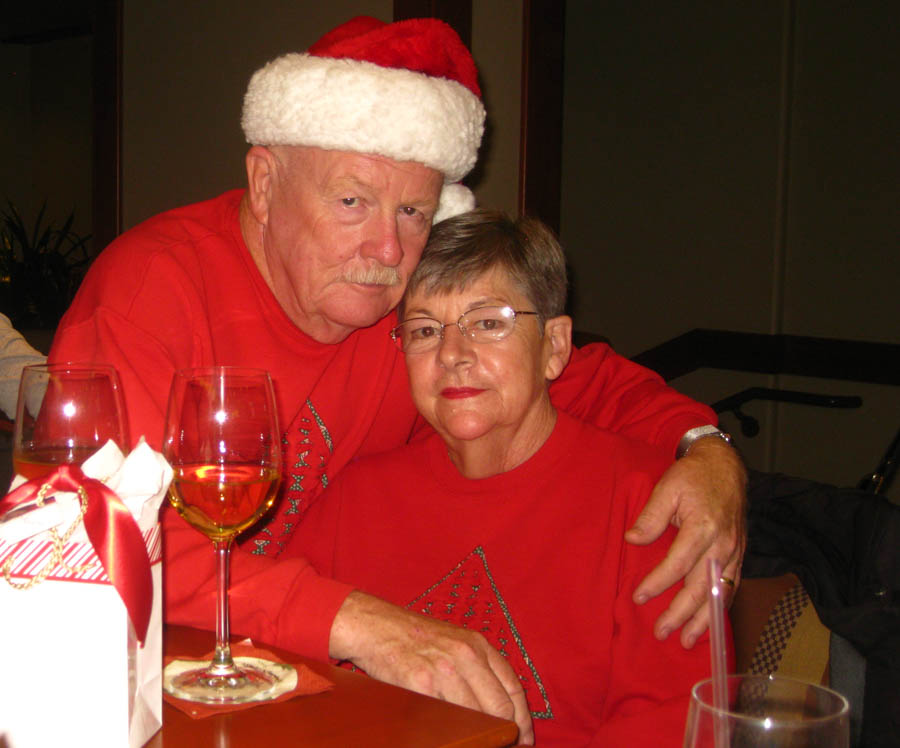Easy Day... To The Movies And Old Ranch
We decided to go to the movies and see Star Wars... We forgot it was two days to Christmas so it took 45 minutes to travel nine miles! We had a drink at Kabuki before seeing the 1:45 show. Good movie and lengthy! Afterwords, we decided to meet up with Teri and Bun along with Greg at Old Ranch!


In summary!
As We Walked Into The Club...

The "Full Cool Moon" is rising!
Why Native Americans Named the Moons
The early Native Americans did not record time by using the months of the Julian or Gregorian calendar. Many tribes kept track of time by observing the seasons and lunar months, although there was much variability. For some tribes, the year contained 4 seasons and started at a certain season, such as spring or fall. Others counted 5 seasons to a year. Some tribes defined a year as 12 Moons, while others assigned it 13. Certain tribes that used the lunar calendar added an extra Moon every few years, to keep it in sync with the seasons.
Each tribe that did name the full Moons (and/or lunar months) had its own naming preferences. Some would use 12 names for the year while others might use 5, 6, or 7; also, certain names might change the next year. A full Moon name used by one tribe might differ from one used by another tribe for the same time period, or be the same name but represent a different time period. The name itself was often a description relating to a particular activity/event that usually occurred during that time in their location.
Colonial Americans adopted some of the Native American full Moon names and applied them to their own calendar system (primarily Julian, and later, Gregorian). Since the Gregorian calendar is the system that many in North America use today, that is how we have presented the list of Moon names, as a frame of reference. The Native American names have been listed by the month in the Gregorian calendar to which they are most closely associated.
Native American Full Moon Names and Their Meanings
The Full Moon Names we use in the Almanac come from the Algonquin tribes who lived in regions from New England to Lake Superior. They are the names the Colonial Americans adapted most. Note that each full Moon name was applied to the entire lunar month in which it occurred.
| Month | Name | Description |
|---|---|---|
| January | Full Wolf Moon | This full Moon appeared when wolves howled in hunger outside the villages. It is also known as the Old Moon. To some Native American tribes, this was the Snow Moon, but most applied that name to the next full Moon, in February. |
| February | Full Snow Moon | Usually the heaviest snows fall in February. Hunting becomes very difficult, and hence to some Native American tribes this was the Hunger Moon. |
| March | Full Worm Moon | At the time of this spring Moon, the ground begins to soften and earthworm casts reappear, inviting the return of robins. This is also known as the Sap Moon, as it marks the time when maple sap begins to flow and the annual tapping of maple trees begins. |
| April | Full Pink Moon | This full Moon heralded the appearance of the moss pink, or wild ground phlox—one of the first spring flowers. It is also known as the Sprouting Grass Moon, the Egg Moon, and the Fish Moon. |
| May | Full Flower Moon | Flowers spring forth in abundance this month. Some Algonquin tribes knew this full Moon as the Corn Planting Moon or the Milk Moon. |
| June | Full Strawberry Moon | The Algonquin tribes knew this Moon as a time to gather ripening strawberries. It is also known as the Rose Moon and the Hot Moon. |
| July | Full Buck Moon | Bucks begin to grow new antlers at this time. This full Moon was also known as the Thunder Moon, because thunderstorms are so frequent during this month. |
| August | Full Sturgeon Moon | Some Native American tribes knew that the sturgeon of the Great Lakes and Lake Champlain were most readily caught during this full Moon. Others called it the Green Corn Moon. |
| September | Full Corn Moon | This full Moon corresponds with the time of harvesting corn. It is also called the Barley Moon, because it is the time to harvest and thresh the ripened barley. The Harvest Moon is the full Moon nearest the autumnal equinox, which can occur in September or October and is bright enough to allow finishing all the harvest chores. |
| October | Full Hunter's Moon | This is the month when the leaves are falling and the game is fattened. Now is the time for hunting and laying in a store of provisions for the long winter ahead. October's Moon is also known as the Travel Moon and the Dying Moon. |
| November | Full Beaver Moon | For both the colonists and the Algonquin tribes, this was the time to set beaver traps before the swamps froze, to ensure a supply of warm winter furs. This full Moon was also called the Frost Moon. |
| December | Full Cold Moon | This is the month when the winter cold fastens its grip and the nights become long and dark. This full Moon is also called the Long Nights Moon by some Native American tribes. |
Note: The Harvest Moon is the full Moon that occurs closest to the autumnal equinox. It can occur in either September or October. At this time, crops such as corn, pumpkins, squash, and wild rice are ready for gathering.
The Ladies Were Awaiting Our Arrival

Bunnaford and Teri were happy to see us!

Big hugs... Keeps us warm!

Photo bombed!

Was was visited by THREE BEAUTIFUL SPIRITS

The bombing run is over!

"Thinking hurts my head!"

"OK... I have thunked enough for one evening!"

